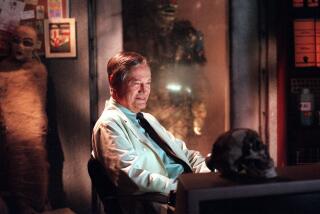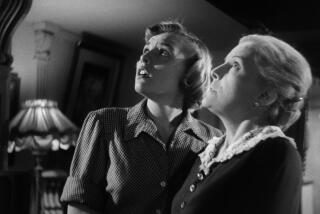Lothrop Worth Dies; Movie Cameraman Inspired ‘50s Revival of 3-D
- Share via
Lothrop Worth, a veteran Hollywood cameraman who inspired the 3-D movie craze of the 1950s, died Thursday at the Motion Picture & Television Hospital in Woodland Hills.
Worth, 96, spent half a century behind the lens, training his camera on some of the most famous faces of his time, including those of Marlene Dietrich, Vincent Price and Gary Cooper.
When he was briefly out of work in the 1950s, he developed a system of cameras and mirrors that created the illusion of depth on the movie screen. Calling the technique “natural vision,” he used it to film the era’s first commercial feature-length 3-D film, “Bwana Devil,” released in 1952 and starring Robert Stack as an engineer who battles man-eating lions in Africa.
The movie so impressed Jack Warner of Warner Bros. that within two days of its release the studio mogul signed Worth and his partner, Trent Baker, to shoot “House of Wax.” That 1953 horror flick, which starred Vincent Price as a mentally warped sculptor who turns people into wax figures, was considered the best and most popular of the 3-D productions from that period.
The first 3-D movie, “The Power of Love,” opened in Los Angeles in 1922, bringing a resurgence of interest in stereoscopic cinema processes that had been developed at the turn of the century. Thus Worth, who was sometimes called the father of 3-D, was always careful to say he was really the father of the 1950s revival, “because 3-D’s been around for eons, even before my time.”
When television began to lure filmgoers away from the box office in the ‘50s, Hollywood rediscovered 3-D. Every major studio and many small ones began to churn out “depthies” or “deepies,” as the movies were sometimes called. But, aside from “House of Wax” and MGM’s “Kiss Me Kate,” also in 1953, most of the attempts to capitalize on the technology fizzled.
By 1954, the 3-D fad was doing a fast fade-out--a merciful development, from Worth’s standpoint.
“All that directors wanted to do was the same old gag of throwing things at the camera,” he told The Times in 1993. “These techniques should come as startling climaxes, but in those early 3-D films, all you had was things flying at your head--axes, leaping lions, African spears, anything they could think of. Done right, it doesn’t hurt your eyes.” But after a while “bad imitators came along, and people went home with a headache.”
Born in Melrose, Mass., Worth moved to Los Angeles with his family after they were bankrupted in a stock market crash in 1907. Growing up near USC, he recalled seeing actors from early westerns strolling through the neighborhood on their way to outdoor sets. That’s when the Hollywood bug bit.
“I was intrigued with it from the time I saw the cowboys and Indians walking down the street,” he told an interviewer last year.
His mother was working as a beautician for the wife of director Cecil B. DeMille when Worth’s father died unexpectedly of a heart attack. Constance DeMille wound up getting the young Worth, then a commerce and business administration major at USC, a job at her husband’s studio.
“The DeMilles thought I should be an actor,” he once recalled. “But I thought I should do something more technical . . . more lasting.”
His first assignment for DeMille was filming titles for the 1923 silent classic “The Ten Commandments.”
He made a brief detour as a sound technician after talking movies emerged, but eventually returned to camera work. He went on to serve as director of photography on such films as “Gog,” “I Was a Teenage Frankenstein,” “Jesse James Meets Frankenstein’s Daughter,” “Billy the Kid vs. Dracula” and “Hostile Guns.”
Worth also worked in TV as director of cinematography on such series as “The Donna Reed Show” and “The Real McCoys.” He coordinated the scenes in which Barbara Eden vaporized into and out of her bottle in “I Dream of Jeannie.”
He worked at all the major studios, retiring in 1969 after a 20-year stint at Paramount Pictures.
Worth was one of the oldest residents at the Motion Picture Country House, part of the health care and retirement-home complex in Woodland Hills run by the Motion Picture & Television Fund. When his wife, Jean, died in 1989, he donated their $700,000 Brentwood house to the fund and moved to the Woodland Hills retirement community. The fund named a wing of its hospital for the Worths.
More to Read
Only good movies
Get the Indie Focus newsletter, Mark Olsen's weekly guide to the world of cinema.
You may occasionally receive promotional content from the Los Angeles Times.











